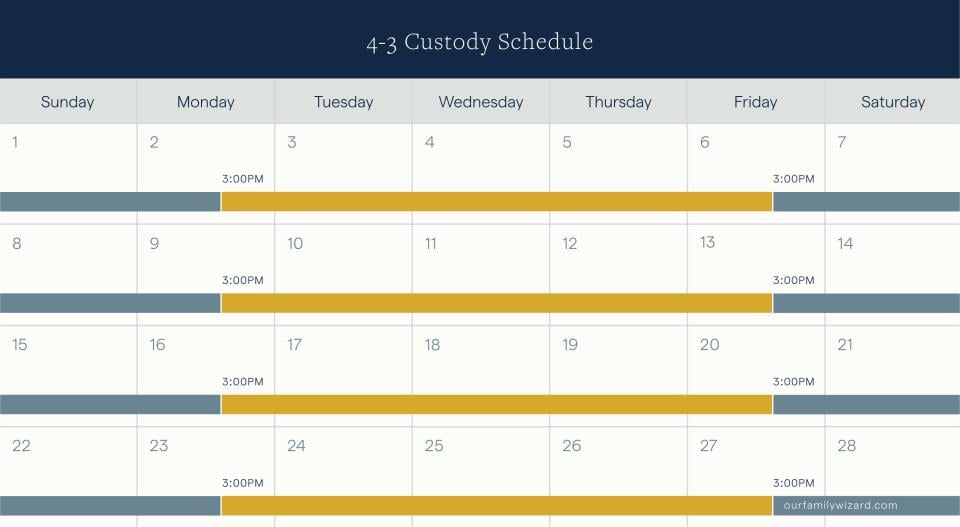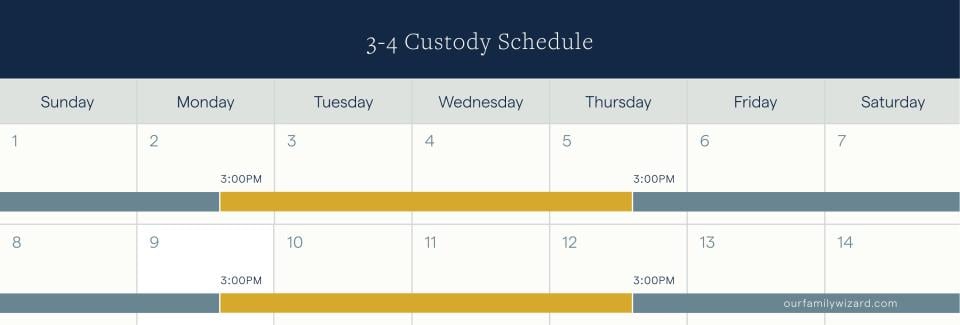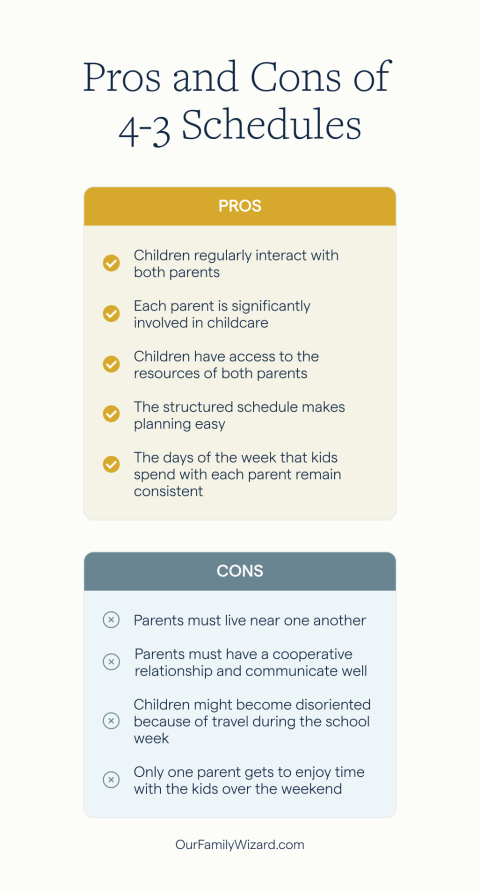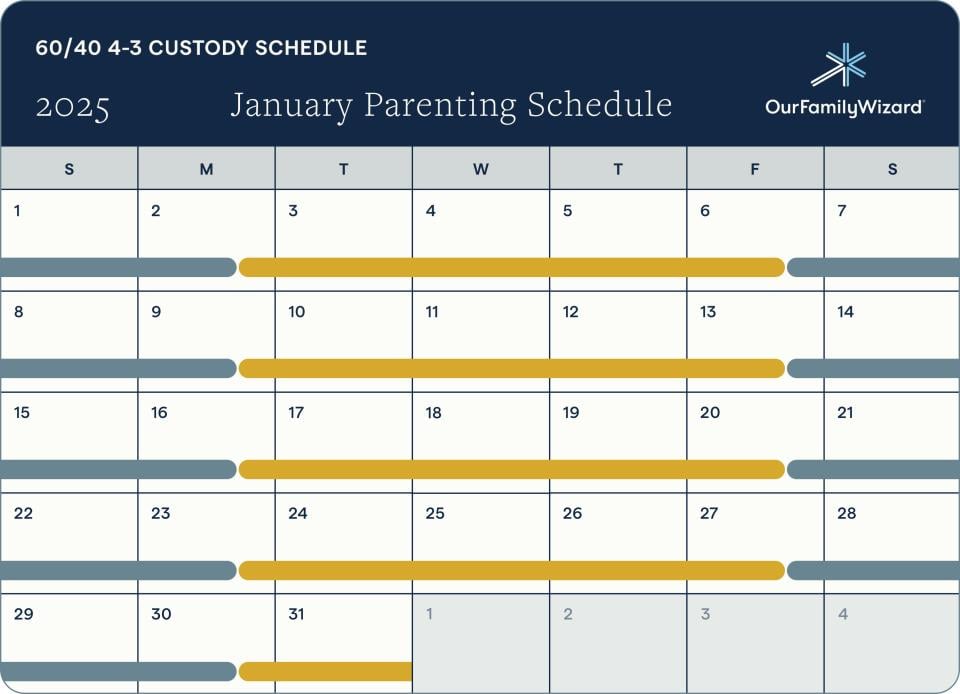4-3 Custody Schedules: Examples, Alternatives, and Expert Tips
With the right co-parenting schedule, the transition to co-parenting can feel healthy, fluid, and easy. Get expert tips on the 4-3 schedule, learn why it's different from 3-4-4-3, and discover how to best manage any parenting schedule.
What Is a 4-3 Custody Schedule?
A 4-3 custody schedule is a type of 60/40 weekly parenting schedule. Each week, one parent has the children for four days, and the other has them for the next three days. The 4-3 arrangement gives children significant time with both parents.
Example of a 4-3 Custody Schedule
You’ll often see the 4-3 schedule rotation referred to as a “custody schedule” or a “parenting schedule.” Many co-parents use and like the 4-3 schedule because it gives them each considerable time with their kids. However, the arrangement also breaks the week up so that one parent has the kids for most of the schooldays, and the other parent gets to be with them for a long weekend.
In general, shared parenting time schedules, like the 4-3 rotation, have received positive reviews from parents and experts alike. However, kids often face the most challenges after a separation, and parents want to put their kids' needs first. One way to put their needs first is to select the right parenting schedule.
In fact, according to a study published in 2018 in the peer-reviewed journal Acta Paediatrica, a growing body of literature points to the idea that, “Children's wellbeing after divorce is related to how children live and keep in contact with their parents after separation." The article summarizes results demonstrating that school-aged children and adolescents in joint custody schedules tend to have better socioeconomic resources, reduced conflict with parents, and well-adjusted personalities.
Of course, every parenting situation is different, and these studies describe trends rather than facts. For example, some parents with more than one child practice split custody, where the siblings are divided between the two parents. Sometimes, each child lives permanently with one parent, and other times the children rotate residing with each parent. The success of custody agreements depends on many factors, some of which only the two parents can understand.
 Anthony Hoover, a Pennsylvania-based family law attorney at Levin Hoover Family Law Firm, comments that most judges and court-appointed professionals in his state believe that children should grow their relationships with both parents. "Most experts believe that, unless there is clear evidence to the contrary, both parents have a lot to offer the children by way of support and personal growth," Hoover says. "Also, the children will benefit from spending time and growing their relationship with both parents and sets of extended families. Finally, the children will also enjoy seeing both parents engaged in their school activities and social lives."
Anthony Hoover, a Pennsylvania-based family law attorney at Levin Hoover Family Law Firm, comments that most judges and court-appointed professionals in his state believe that children should grow their relationships with both parents. "Most experts believe that, unless there is clear evidence to the contrary, both parents have a lot to offer the children by way of support and personal growth," Hoover says. "Also, the children will benefit from spending time and growing their relationship with both parents and sets of extended families. Finally, the children will also enjoy seeing both parents engaged in their school activities and social lives."
With these important foundational concepts in mind, parents who strive for joint parenting time should learn about the 4-3 schedule.
Key Takeaways
- The 4-3 schedule is a 60/40 weekly schedule where one parent cares for the kids for four days and another for three days.
- The 4-3 schedule works best for parents who live near one another and have a healthy co-parenting relationship.
- Family law professionals state that many kids like that a 4-3 schedule gives them ample time with both parents.
- In a 4-3 schedule, one parent will get all the weekend time, which can create tension.
- A co-parenting calendar can help parents easily create, track, and manage a 4-3 schedule.

4-3 vs 3-4 vs 3-4-4-3: What’s the Difference?
Sometimes, people confuse different parenting time arrangements like 4-3, 3-4-, and 3-4-4-3. Here’s what you need to know.
What’s the Difference Between 4-3 and 3-4-4-3?
The 4-3 custody schedule is a 60/40 time arrangement, whereas the 3-4-4-3 custody schedule, which is a 50/50 time arrangement.
In a 3-4-4-3 schedule, the allotted time with the kids switches every week. So, if you’re with the kids for four days in the first week of the month, you will be with them for three days in the second week. This allows you and your co-parent to have the same number of days with your kids per 2-weeks, splitting your time with them 50/50.
In a 4-3 schedule, the number of days spent in a row with the kids is the same every week for each parent. That means that one parent will always spend 4 days a week with the kids, and the other parent will always have them 3 days a week. This rotation will remain the same every week, so it adds up to a 60/40 arrangement of parenting time.
What’s the Difference Between 4-3 and 3-4?
Essentially, the 4-3 and 3-4 schedules are the exact same rotation, and both provide a 60/40 (or 40/60) parenting time arrangement. The only difference is how the rotation starts.
A 3-4 schedule is a variation of a 4-3 schedule in which the first block of time in the week lasts for three overnight visits. A 4-3 schedule is the reverse: the first block of time in the week lasts for four overnight visits.
You and your co-parent can design a 4-3 or 3-4 schedule however you would like. This includes deciding on which day of the week you start your rotation. For example, if the schedule starts on Tuesday, the first parent will be with the kids Tuesday through Friday, and the second Saturday through Monday. Then, the first parent will have the child Tuesday through Thursday, and the second parent will have them from Friday through Monday. In this case, Friday is the alternating day.
Example of a 3-4 Custody Schedule
Examples of 4-3 Schedules
For example, if you want to have exchange days on Fridays but start the schedule on Tuesdays, the first parent would have the kids for Tuesday, Wednesday, and Thursday nights, with an exchange on Friday. Because the schedule starts with a three-day block and follows with a four-day block, experts call this variation a 3-4 schedule.
As in the example above, you can change the days and pickup times of the 4-3 schedule to match your families' unique circumstances. For instance, you can set exchange times to be in the morning or midday, based on your kids’ school schedule. You can also add visits to account for times when your children aren’t with you or your co-parent, like when they are at school, at friend‘s houses, or at daycare. Instances like these are sometimes referred to as ”third-party time.”
Still, many parents with school-aged kids opt to start the schedule on Mondays to be consistent with the beginning of the school week. But in this situation, one parent has the kids for the entire weekend every week. If that doesn’t sound appealing, know that you could integrate a weekend exchange day into the schedule so that both you and your co-parent can each have a little weekend time with your children.
Who Is a 4-3 Child Custody Schedule Good For?
The 4-3 custody schedule works best for involved co-parents who live near one another and maintain a productive parenting relationship. Also, many younger children like the 4-3 schedule because they see both parents regularly.
Here are some characteristics of a family that may excel under the 4-3 schedule. Note that some of these considerations may change as a child grows older.
- Parents near one another:
The 4-3 schedule requires one exchange per week. If you and your co-parent live more than 10 to 15 miles away, you, your kids, and other caregivers will spend significant time in the car traveling from home to home. We all know how frustrating it can feel to commute for long periods.
Also, you and your co-parent must exchange clothing, schoolbooks, sporting equipment, and other personal items. Though you can keep some duplicate items in both houses, like formula, or clothing, this method only works for some things and can be expensive.
For example, schoolwork commonly slips between the cracks when a child travels from home to home. If a child accidentally leaves her spelling homework at your co-parent's house, but she is with you, you and your co-parent will need to arrange a quick meet-up. If either one of you can't accommodate a last-minute change, the child may fall behind in her schoolwork and feel frustrated and stressed.
In general, kids whose parents live near the same bus stop or in the same school district will experience fewer disruptions to their schedules and adjust better to a 4-3 rotation. - Parents engage in accessible communication and healthy co-parenting:
The experts agree: One of the most important aspects of the 4-3 schedule is that the co-parents must cooperate. Family law attorney Alexandra (Lexie) Rigden echoes that thought: "As in any shared arrangement, the parties need to be able to co-parent reasonably well because both parents will be spending a lot of time interacting with one another as they share in the life of their child."
Family law attorney Alexandra (Lexie) Rigden echoes that thought: "As in any shared arrangement, the parties need to be able to co-parent reasonably well because both parents will be spending a lot of time interacting with one another as they share in the life of their child."
Setting up and following through with a schedule requires that both parents can communicate with one another quickly and effectively. Co-parents in high-conflict relationships who struggle to communicate effectively may not do well with regular interaction. - Parents have flexible work schedules:
No matter how you organize the 4-3 schedule, there will be an exchange day during the week. This may be difficult to manage if you or your co-parent have rigid 9-5 jobs and can't take time out during the week to pick up kids if your parenting time exchange falls during your workday. The situation can be even more difficult if either of you don't have the resources to pay for a caregiver to help.
You can mitigate this problem if you live near one another and your children are in school. In this case, the kids can take the bus in the morning from your house and then take the bus back to your co-parent's house, making the exchange seamless and hassle-free - Young children (pre-K and younger) and children with secure attachment:
Shared arrangements work well for young children who are still forming a relationship with their parents. Also, because only one parent cares for the children over the weekend, this schedule can be perfect for young kids, like toddlers and infants who don't attend school.
Finally, the 4-3 schedule provides stability and predictability that young children need to form an attachment to both parents. Attachment theory describes the four principal ways children become attached to their parents. In general, children who exhibit a secure attachment style have positive relationships with their parents. Research suggests that, ”Young children need stability and predictability in their relationships with their caretakers since their first attachment relationships are still developing."
Likewise, older children who already have formed secure attachments to their parents will not want to be away from either parent for too long. In this case, the 4-3 schedule facilitates a healthy attachment style and fosters secure relationships that have already formed. - When one parent is unavailable on the weekend or during the week:
 Dr. Tara Egan, a co-parenting therapist, describes the 4-3 schedule as best for situations "when one parent is only available on the weekends. “For example, the parent may work or live too far away to be in the same area as the children during most of the school week. Or, the parent may have a disability, and only have caretaker availability on the weekends, meaning the kids could only be around during these times."
Dr. Tara Egan, a co-parenting therapist, describes the 4-3 schedule as best for situations "when one parent is only available on the weekends. “For example, the parent may work or live too far away to be in the same area as the children during most of the school week. Or, the parent may have a disability, and only have caretaker availability on the weekends, meaning the kids could only be around during these times."
Family law attorney Rigden agrees, pointing out, "Maybe one parent works every weekend, so it is better for them to have weekday, as opposed to weekend, time." For example, one parent might work three-day weekends as a nurse for 12-hour shifts. In this case, the 4-3 schedule would accommodate that parent's work schedule.
Simplify your 50/50 custody schedule
Keep your co-parenting organized with OurFamilyWizard.
Benefits Of a 4-3 Joint Custody Schedule
The main benefit of a 4-3 joint custody schedule is that each parent spends significant time with the children. Likewise, children won't go long without seeing a parent. Also, the structured schedule can make planning other commitments easier.
Here's a summary of the benefits of a 4-3 joint custody schedule:
- Each parent spends significant time with the children
Because each parent will have a lot of time, the schedule may reduce conflict or feelings of resentment from a parent who doesn't believe they have enough time. - Children have frequent contact with both parents
For younger children, regularly interacting with both parents is crucial to building a relationship that will affect the child's life well into adulthood. - Children have access to the extended family and resources of both parents
- Children will be exposed to the unique hobbies and parenting styles of both parents
The 4-3 schedule offers balanced parenting opportunities, where you and your co-parent can expose your kids to your unique perspectives and favorite activities. Consequently, your kids will grow up exposed to different points of view, helping them become more well-rounded and increasing the likelihood of connecting to an activity or community. - Days of the week remain consistent
In a 4-3 schedule, the days each parent cares for the kids never change. This contrasts with other common schedules, like a 2-2-3 schedule. But, unlike other schedules with mostly consistent days (like a 5-2-2-5), the 4-3 provides solid structure while limiting how long a child goes without seeing the other parent.
Rigden adds, "Parents usually adjust to their parenting time schedules, and many take full advantage of and enjoy their free time." The 4-3 schedule gives parents enough organization to easily plan other social engagements or commitments. Also, there won't be any confusion as to who will be responsible for extracurricular activities, practices, or hangouts that happen at the same time every week.
It's not just the parents who may enjoy the routine, either. In other schedules, children may feel confused and unsure of which house they will end up in that night. On the other hand, most children will quickly adjust to the 4-3 schedule and associate most of the school week with one parent and a long weekend with another.
Cons Of a 4-3 Joint Custody Schedule
The 4-3 joint custody schedule presents logistical challenges for parents who don't cooperate well or live far away. Also, more difficult caretaking falls on the weekday parent, creating tension. Finally, some children prefer to switch homes less frequently.
Dr. Egan emphasizes these and other challenges.: "It is difficult for any parent to make the 4-3 schedule sustainable because one parent tends to do all the caretaking during the week."
"One parent is likely balancing childcare and work responsibilities, shouldering all the tedious parenting tasks (homework, getting them up for school, transporting them to weekday activities) and, as a result, enjoying little downtime on the weekend,” she explains. “This situation can cause tension between parent and child, and resentment between co-parents. For example, if one parent is not viewed as ‘strong’ in helping children with school, this can negatively impact the parent and child relationship because one parent will be viewed as the ‘fun parent’ and the other as the ‘school parent.’”
Family law attorney Rigden echoes Dr. Egan’s concerns, stressing that the weekday and weekend schedule can make both parents feel like they're missing out for different reasons. "One parent may have the child every weekend, which may impact that parent's social life,” says Rigden. “On the other hand, the parent who does not have weekend time with the child will have the same number of overnights but less time with the child because, during the majority of that parent's time, the child will be in school and the parent, presumably, will be at work."
Here's a summary of these and other challenges of the 4-3 custody schedule:
- Parents must live near one another.
- Parents should have a cooperative relationship and communicate well. Otherwise, tension will build.
- More sensitive children may feel disoriented and experience "jetlag" days from spending parts of the school week at different homes.
- The schedule can stress children as they try to ensure they have everything they need at each home.
- Children may view one parent as the "fun" weekend parent and the other as the "responsible" weekend parent.
Sometimes you need to visualize a new custody schedule before it can make sense. Map out a 4-3 custody schedule by downloading this free template. This will let you experiment with start and exchange days to create your family's personalized 4-3 plan.
Before jumping into any parenting arrangement, you should take a macro-level look at a sample template. Next, overlay the template with everyone's calendar–yours, your co-parent's, and your kids’—so you can understand how the 4-3 will affect work, school, extracurricular activities, and play dates. Then, ask yourself some questions, such as will the schedule work better if it starts on Monday or Tuesday? Should we set up exchange times first thing in the morning or after school?
Questions to Ask When Considering a 4-3 Parenting Schedule
When considering a 4-3 schedule, asking questions can guide your decision-making process. For example: Do you and your co-parent live near one another? Are you both on board with one parent having most weekend time? What do your kids think?
The 4-3 rotation offers many advantages for parents and children that thrive under a joint parenting agreement, but it also has drawbacks. Be sure to consider some key questions to capture the unique advantages and disadvantages of 4-3 when applied to your situation.
Also, remember to keep your child’s opinions in mind about where they wish to spend their time. As family law attorney Rigden suggests, "A child's preferences should always be considered, assuming the child is of a sufficient age and maturity level to weigh in."
Here's a list of questions for both parents to consider:
- Do you and your co-parent live close to each other (within 10 to 15 miles, give or take)?
- Do you both have a productive, cooperative relationship? Or will managing the schedule create tension cascading down to the kids?
- Will your kids benefit from equal time with each parent? Have they already formed secure attachments that need time with each of you to sustain?
- Do you and your co-parent have enough resources to mitigate the stress your children may experience by rotating homes in this way? For example, can you each help them pack ahead of exchanges and purchase duplicate items to have at both houses?
- Does one parent's schedule lend itself to weekday or weekend time with the kids?
- Are you and your co-parent okay with one of you having the bulk of weekend time? Or, would you both be comfortable with exchanging parenting time on a Saturday to even out the weekend time?
- When your kids are in school, can the weekday parent handle tedious school-week parenting tasks, like helping with homework? Will the mismatch between weekday and weekend caretaking create resentment between you and your co-parent, or you and your kids?
- Are other caregivers or family members nearby to help if an unanticipated event creates an issue in the schedule?
Alternatives to 4-3 Parenting Schedules
The 4-3 parenting schedule represents just one type of shared parenting arrangement. Consider some other options like the 2-2-5-5 or 2-2-3 schedules. These schedules split time evenly but require more exchanges. Like the 4-3, each schedule offers benefits and challenges.
Here are some common parenting schedule alternatives to the 4-3:
- 3-4-4-3 schedule
A 3-4-4-3 schedule is a 50/50 schedule where parents alternate caring for the kids for at least one day of the week, usually Sunday. The schedule rotates on a two-week basis. You might also see this one called 3-3-4-4, 3-4-4-3, or 4-3-3-4. They’re all the same type of schedule, but what you call it just depends on which pattern you use. - Every extended weekend schedule
In every extended weekend schedule, one parent cares for the children for three weekend nights, and the other for four weekday nights. This schedule is common for parents who live far from one another, or in situations where one parent cannot be as involved in the kids' lives for whatever reason. Co-parents commonly make slight changes to this schedule to account for third-party time. - 2-2-5-5 schedule
The 2-2-5-5 custody schedule splits each week into two-day and five-day periods. Here, a child spends two days with each parent and then five days with each parent. - 2-2-3 schedule
In a 2-2-3 custody schedule, the first parent cares for the children for two days, and then the kids go to the other parent for the next two days. Then, they return to the first parent for three days.
Easiest Way to Manage a 4-3 Parenting Schedule
Scheduling is just one of many challenges in co-parenting. With a calendar designed specifically to help co-parents manage how they split time with their kids, OurFamilyWizard offers easy ways to manage a 4-3 schedule.
OurFamilyWizard’s interactive calendar and palette of tools help the entire family manage and track their time. Plus, with built-in tools to help you handle one-off swaps in parenting time, you won't have to worry about a change messing up the rest of your calendar.
OurFamilyWizard makes creating, editing, and managing shared parenting schedules simple and pain-free. The app is built to meet the unique challenges of co-parenting, from scheduling and messaging to expense tracking, file sharing, and more.
If you think the 4-3 schedule will work for your family, you can quickly set up the schedule in the OurFamilyWizard Calendar and try it out.
FAQ About a 4-3 Joint Custody Schedule
What Is a 4-3 custody schedule?
In a 4-3 custody schedule, one parent has the children for four days, and then the children live with the other parent for the next three days. The 4-3 arrangement is one version of a 60/40 parenting time split.
What percentage is a 4-3 custody schedule?
A 4-3 custody schedule is a 60/40 parenting time split. The parent with four days a week has 60% custody, and the parent with three days a week has 40% custody. This is one of the simplest 60/40 schedules.
Benefits of a 4-3 joint custody schedule
In a 4-3 parenting time schedule, each co-parent gets significant, frequent, predictable time with the kids. The days of the week for exchanges remain consistent (e.g., pick up on Sunday and drop off on Thursday), which promotes stability.
Is 4-3 the best custody schedule?
Every family is different, but a 4-3 parenting time schedule could be a great fit for your family. If you and your co-parent get along pretty well, and you’re willing to take all weekends or no weekends, 4-3 could work.
Is 60/40 considered joint custody?
Yes, 60-40 is joint physical custody: Legally, your child lives with you part of the time and their other parent part of the time. Legal custody is separate, but it’s uncommon to have joint physical custody without joint legal custody.
Who is a 4-3 child custody schedule good for?
The 4-3 parenting time pattern is great for parents who live nearby and communicate well, so that it’s easier to have twice-weekly exchanges. It also helps to have flexible work schedules so that a midweek drop-off/pick-up is doable.
It’s also a good schedule if one parent works during the week, and the other works the weekend. Young children tend to thrive in this schedule because the transitions aren’t so frequent that they’re disruptive, but the children don’t have to go too long without seeing either parent.
Cons of a 4-3 joint custody schedule
The biggest downside to a 4-3 parenting time schedule is that one parent gets all the weekends and the other gets none. You might miss the weekday routines and school involvement or miss the fun free time on the weekends.
If you have the kids on the weekend, it’s harder to schedule personal outings or activities that don’t involve the kids. If you have the kids during the week, it’s harder to schedule appointments or juggle childcare.
4-3 vs 3-4: What’s the difference?
4-3 and 3-4 are very similar: One parent gets four days a week, and the other parent gets three days a week. The difference is whether the rotation starts with four or three. Both patterns are a 60/40 split.
For example, in a 4-3 rotation, one parent might have the kids Sunday evening through Thursday evening, and the other parent has them Thursday through Sunday. In 3-4, the midweek exchange might happen on Wednesday instead of Thursday.
4-3 vs 3-4-4-3: What’s the difference?
The biggest difference between 4-3 and 3-4-4-3 is the breakdown of custody percentage. A 4-3 schedule pattern is a 60/40 split, while a 3-4-4-3 pattern is a 50/50 split. Both are consistent, predictable patterns that can establish stability.
A Note on Terminology
In general, the term “physical custody” refers to which parent a child lives with. Today, many experts use other terms to describe this arrangement, like “parenting schedule” or “parenting time arrangement.” These new terms better represent a relationship and the parent’s responsibilities for their children. But just a heads up: this article uses these older and newer terms interchangeably.





